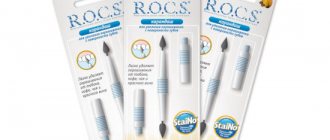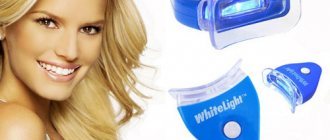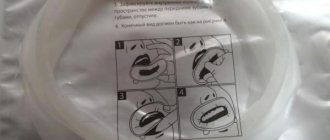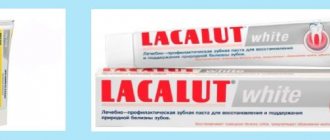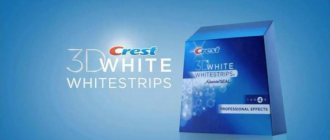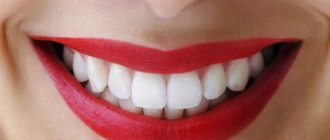From this article you will learn:
- whitening strips – reviews, before and after photos,
- differences between Crest and Blendamed strips,
- price of strips in a pharmacy for 2022.
The article was written by a dentist with more than 19 years of experience.
Whitening strips are designed for chemical teeth whitening at home. The whitening effect is achieved due to hydrogen peroxide, which is applied in the form of a gel to the inner surface of the strips. Their advantages include ease of use, good effectiveness, and a much more affordable price compared to whitening at the dentist.
In Russia, the most well-represented strips for teeth whitening are produced under the brands “Crest 3D White” and “Blendamed 3D White Luxe”. This creates the illusion of choice, but in fact both brands are owned by the same (USA). Compared to Blendamed strips, Crest strips have a higher concentration of hydrogen peroxide.
Teeth whitening strips Crest 3D White and Blendamed 3D White Luxe are good marketing products. You don't have to go to the dentist. It is much cheaper than in the clinic. But why then are the reviews of a fairly large part of patients on teeth whitening strips still far from enthusiastic? In this article we will talk not only about the undoubted advantages of their use, but also the problems that you may encounter.
How do teeth whitening strips work?
Most home teeth whitening systems contain hydrogen peroxide or carbamide peroxide as an active ingredient. Different types of Crest 3D White strips contain different concentrations of hydrogen peroxide - from 9.5 to 14% (we will discuss each type of Crest strips in detail below), and Blendamed 3D White Luxe whitening strips contain 5.25% hydrogen peroxide.
Solutions of hydrogen peroxide and carbamide peroxide are capable of penetrating deeply into tooth tissue with prolonged exposure - to the entire thickness of enamel and dentin. Having penetrated inside, these peroxide compounds decompose there to form free radicals (active oxygen). It is free radicals that lead to the destruction of molecules of chromogenic substances, which give teeth pigmentation.
However, free radicals are not stable compounds and quickly decompose. Therefore, to obtain a whitening effect, hydrogen peroxide must be in contact with the teeth for a sufficiently long time, and it is also necessary to maintain a sufficient concentration. The lower the concentration of hydrogen peroxide in the strips, the longer they will have to be used to get the desired effect.
Teeth whiteners on Aliexpress: examples of reviews
As we have already said, whitening products are not effective in every case. On Aliexpress, you need to select them carefully and study the reviews of other buyers. It is the opinion of those who have already placed an order that will help you make your choice. You can find them on a special tab on the product page:
Reviews
Whitening strips Crest 3D White –
Crest strips for teeth whitening (Crest 3D White) - available in 6 different versions. They differ in different concentrations of hydrogen peroxide, the number of strips in the package, and the exposure time of the strips on the teeth. One of the strip options even has a special light source, which apparently should give the consumer the illusion that this product is similar to professional “laser” whitening systems.
But what's really important is that different types of strips hold onto the teeth differently. Some of them can slip on the teeth and do not stick well. When choosing Crest strips, pay attention to the fact that they contain Advanced Seal® technology (allows the strips to adhere firmly to the teeth and not slip on them). Otherwise, the strips will peel off and there will be no close contact of the whitening gel with the enamel surface.
If you have an uneven dentition/crowded teeth, or a pronounced inclination of some teeth, the FlexFit® technology will allow you to achieve good adaptation of the strips to the surfaces of all teeth. In this case, the strips will be slightly elastic (stretch), which will allow them to better adapt to uneven tooth surfaces or uneven dentition shapes. Only Crest 3D White “Supreme FlexFit” strips have this technology. If the strips do not adhere tightly to some surfaces, then the teeth in these areas will remain dark.
The best systems from AliExpress with whitening gel
A teeth whitening system is a kit that consists of a gel or strips containing at least 10% carbamide or hydrogen peroxide, an LED or infrared lamp and a custom tray. Whitening occurs due to the release of active oxygen under the influence of light radiation from a lamp.
The bleach is applied using a tray, then the lamp is turned on. The enamel pores open, active oxygen penetrates inside and removes darkening. After the procedure, the dentinal tubules remain open, so some manufacturers complete kits with products containing minerals that strengthen the enamel (hydroxyapatite, calcium, potassium, magnesium).
Whitening strips: reviews
Let’s say right away that the Crest 3D White “Vivid” strips and especially the Blendamed 3D White Luxe will receive the least good reviews. These versions of the strips do not hold onto the teeth well enough, they slide over them, and if salivation is quite active, it will not be possible to fix them well on the teeth at all, as a result of which there will be no necessary tight contact of the whitening gel with the enamel.
The reviews for White Light teeth whitening are satisfactory. In professional whitening techniques, light sources are used to accelerate the breakdown of hydrogen peroxide in the whitening gel into free radicals, and exposure to light is carried out not after, but during the procedure. In Crest 3D White “With Light” strips, the light is used for 10 minutes after the end of the procedure and, thus, it is not intended to activate the whitening gel.
The portable White Light lamp does not have its own whitening effect, because it is a source of light waves in the “blue” range, and only light waves in the ultraviolet range have a slight whitening effect. Therefore, we believe that the light source in these strips is purely a marketing ploy to make this procedure look like professional laser whitening. This allows us to sell 10 sets of Crest White Light strips - at the price of 20-40 sets of similar sets.
Which Crest strips are better –
We consider the best option for strips to be Crest “Supreme FlexFit”, which is tightly fixed to the teeth and allows the strips to adapt well even in areas of uneven teeth. In 2nd place we would put the Crest “Professional Effects” strips. But we do not recommend using Crest “Supreme Professional” strips with 14% hydrogen peroxide. The fact is that even if the strip does not come into contact with the gums, hydrogen peroxide always gets into the oral fluid due to the contact of the gel with saliva. Therefore, when using a 14% concentration, gum burns and a burning sensation in the throat will be practically guaranteed.
Please note that different versions of strips with the same concentration of hydrogen peroxide of 10% are recommended for different times. Moreover, where the exposure of the strips is 30 minutes, the whitening goes by 3-4 tones, and where the exposure is 60 minutes, by about 6-8 tones. In our opinion, the manufacturer deliberately recommends using essentially the same strips - for different times, so that it does not turn out that cheaper strips will be as effective as more expensive ones.
Crest Professional Effects Strips – Before and After
Crest Vivid strips – before and after photos
CONCLUSIONS: in general, the effectiveness of whitening strips can be very high, and under certain favorable conditions (straight teeth, absence of pigment plaque and dental deposits on the teeth, etc.) - the effect of such home therapy can be practically no different from the result of professional whitening in dentist However, before you buy teeth whitening strips, also read about their disadvantages, which we will tell you about later.
Comparison table of characteristics
In order to compare the presented products, we recommend that you study the table with characteristics in the article below.
| Model | Duration of procedure (min) | Course duration (days) | Whitening tone | Price, rub) |
| Crest 3D White Gentle Routine | 30 | 14 | 1-2 | from 3190 to 5600 |
| Crest 3D White Glamorous White | 30 | 14 | 4 | from 3590 to 5780 |
| Crest 3D White Professional Effects | 30 | 20 | 5 | from 4700 to 6800 |
| Crest 3D White Supreme FlexFit | 60 | 21 | 5 | from 2399 to 4500 |
| Crest Supreme Professional Whitening | 30 | 21 | 6-7 | from 5990 to 7800 |
| Crest 3D White Classic Vivid | 30 | 10 | 2-3 | from 2590 to 3690 |
| Crest 3D White With Light | 60 | 10 | 8 | from 6290 to 8700 |
| Global White Charcoal | 30 | 7 | 3 | from 799 to 1200 |
| Blend-a-med 3D White Luxe | 30 | 7 | 5-6 | from 2600 to 3010 |
| My Brilliant Smile based on activated carbon and coconut oil | 30 | 7 | 10 | from 2350 to 4000 |
Side effects and disadvantages of whitening strips –
Reviews for whitening strips on all sites are written as carbon copies; the texts of the reviews are more like advertising brochures that praise the strips from different angles, keeping silent about the shortcomings. And although home whitening techniques can indeed be very effective, teeth whitening strips still have significant disadvantages...
They do not whiten fillings and crowns -
Chemical whitening allows you to lighten only the tooth tissue. Fillings, veneers, and any types of artificial crowns cannot be bleached. This means that if you have fillings or crowns on one or more teeth, then after whitening they will look even darker against the background of the whitened enamel of the remaining teeth (Fig. 14). Whitening in such situations will mean the need to subsequently replace veneers, crowns and fillings with lighter shades.
It should also be taken into account that after a few months, the teeth will gradually begin to darken again (the speed of teeth darkening after whitening is related to your habits, for example, smoking, the frequency of drinking coloring drinks and foods). This may mean the need for either new replacement fillings, veneers or crowns, or ongoing periodic courses of home whitening.
Uneven whitening –
Reviews of teeth whitening strips are often negative due to the fact that although the front surfaces of the teeth become much whiter, they remain dark in the interdental spaces. This creates a sharp contrast between dark and light, and the interdental spaces end up looking like black triangles (Fig. 15). Why is this happening...
Firstly, the thickness of the whitening gel on the inner surfaces of the strips is only about 0.2 mm. At the same time, the surface of the teeth is not absolutely smooth, and therefore, when adapting the strips to the teeth, the whitening gel simply does not penetrate sufficiently into the interdental spaces. The second reason lies in the uneven position of the teeth, for example, when they are crowded. In this case, adapting the whitening strip to teeth located deeper (lingually) will be very false, which will mean poor contact of the whitening gel with these teeth.
Thirdly, the problem is that most people use Blendamed or Crest whitening strips without first removing plaque and plaque from the dentist. The fact is that the surfaces of teeth covered with pigment plaque whiten a priori much worse, because coating on these areas will prevent hydrogen peroxide from penetrating into them. And therefore the surface of the teeth in these areas will remain dark.
Pain and sensitivity of teeth -
Clinical studies by Cooperetall in 1992 showed that the penetration of free radicals into the dental pulp occurs within 15 minutes after applying 3% hydrogen peroxide gel to tooth enamel. It is this process, as well as a certain degree of demineralization of enamel and dentin, that leads to the development of increased sensitivity of teeth after whitening.
Sensitivity is expressed in the appearance of pain to thermal stimuli (heat, cold). And the longer the bleaching course continues and/or the higher the concentration of hydrogen peroxide, the stronger the sensitivity will be every day. In this case, you can start using special pastes to relieve sensitivity, or reduce the exposure time of the strips on the teeth, or start using them every other time. And after completing the whitening course, it is worth taking a course of remineralization or fluoridation of teeth.
Important: if you have erosions, carious lesions, deep wedge-shaped defects with exposed dentin on your teeth, then you can predict a very high rate of hydrogen peroxide entering the dental pulp (neurovascular bundle) - with the development of severe pain, and even a chemical burn of the pulp , which may then even require removal of the nerve from the tooth. Therefore, caries and wedge-shaped defects must be cured before using whitening strips (24stoma.ru).
Burns and inflammation of the gums, throat irritation -
About half of all patients also complain of sore gums after using whitening strips. The fact is that the whitening strips have a straight shape - in contrast to the gum line, and therefore, when applying the strips to the teeth, they always come into contact with the interdental gingival papillae. As we said above, the strips are coated with a gel with hydrogen peroxide with a concentration of 5.25 to 14% (10% on average), which contributes to the development of a chemical burn of the gums.
Inflammation and burn of gums after whitening –
But gel with hydrogen peroxide can cause harm not only to the gums. The whitening gel is located in the moist environment of the oral cavity, so some of the hydrogen peroxide necessarily gets into the saliva. This means that hydrogen peroxide will affect not only the interdental papillae, but also other areas of the gums and the tongue. In addition, when you swallow saliva, hydrogen peroxide will contact the mucous membrane of the throat, causing irritation. To reduce such side effects, always rinse your mouth after removing strips, reduce exposure time, or use strips with a lower concentration.
White spots on teeth -
When you remove the whitening strips, you can often notice white spots appearing on the enamel. In most cases this is not a problem, because... occurs due to drying out of the enamel area due to the fact that the strips isolate the front surface of the teeth from contact with saliva. Such stains disappear after a few hours (after the enamel is saturated with moisture).
However, if you use low-quality whitening strips (the whitening gel will have an acidic pH), you can end up with chalky white spots on your enamel that will last a lifetime. This can also happen if the enamel of your teeth has poor resistance to chemical and mechanical factors, which occurs against the background of demineralization of the enamel. Generalization means that your enamel contains very little calcium, i.e. as if porous.
If there are white chalky spots on your teeth even before whitening, then this is one of the signs of enamel demineralization, which means that any type of chemical whitening will be contraindicated for you. The use of chemical bleaching against the background of enamel demineralization will lead to an even greater loss of calcium from dental tissues, which will increase the risk of tooth decay (as a result of increased abrasion or the development of caries).
The best teeth whitening system according to professionals
In terms of influence on a person’s attractiveness, hardly anything else can compare with a beautiful smile. A beautiful smile means, first of all, white teeth. However, white teeth do not mean healthy. Therefore, let’s try to figure out how to whiten teeth without harming their health, and which whitening system is better?
History knows that people have always been looking for a means to whiten their teeth.
The practice of teeth whitening dates back more than two thousand years. To obtain a more effective result, healers of the Slavic peoples, before bleaching, polished the surface layer of enamel with a metal file, after which they used a weak solution of nitric acid.
This technique was used until the end of the 18th century. Interest in issues of smile and dental aesthetics became especially evident at the beginning of the 19th century.
The most effective method of teeth whitening was the active element in which was chlorine, obtained from a solution of calcium hydrochloride and acetic acid.
I think it is obvious to everyone that such whitening methods caused irreparable damage to the teeth. But, as they say, “beauty requires sacrifice.”
Fortunately, in the modern world you can achieve beautiful teeth without damaging them.
Already by 1910, all teeth whitening techniques involved the use of hydrogen peroxide along with a heated instrument or light exposure. And in 1918, the principle of activating bleaching using thermal radiation was discovered.
High-intensity light radiation causes a rapid rise in temperature in the hydrogen peroxide solution, which leads to a rapid acceleration of the chemical processes of bleaching. This principle has been improved in many ways, but it still underlies modern teeth whitening systems.
In the 21st century, we can safely say that safe teeth whitening exists, but we will return to this later.
There are the following types of teeth whitening::
- home (carried out independently at home);
- office (clinical, performed by a dentist in a clinic)
In terms of the principle of action, home and office whitening are no different.
Whitening occurs by exposing the pigment inside the tooth to a whitening gel, usually containing hydrogen peroxide or carbamide peroxide.
Hydrogen peroxide and carbamide peroxide act as powerful oxidizing agents, breaking down into water, oxygen and free radicals (atomic oxygen). Hydrogen peroxide releases most of the reactive oxygen species within 30-60 minutes after use. Carbamide peroxide releases about 50% of the active substances in the first 2-4 hours, and the remaining 50% over the next 2-6 hours. The decomposition time is the main difference between these two substances.
The free radicals released affect the tooth pigment found in dentin. It has a yellow or gray color due to double carbon bonds. The pigment transfers this color to the teeth.
When atomic oxygen acts on pigment molecules of hydrogen peroxide or urea, the “colored” double bonds of the pigment are replaced by “colorless” single bonds. As a result, the tooth loses its yellow tint and becomes whiter. This is the mechanism underlying all modern whitening methods.
Please note: only your own teeth are whitened. Fillings, veneers, and crowns have a completely different structure, and whitening technologies do not work on them.
Contraindications to any type of whitening
There are a number of contraindications to the whitening procedure. Such as:
- the presence of allergic reactions to hydrogen peroxide or other components of bleaching systems;
- dental diseases (caries, gingivitis, periodontitis - first they need to be eliminated);
- pathological abrasion of teeth or deep cracks in the enamel;
- oncological diseases;
- some mental illnesses;
- taking a number of drugs that increase photosensitivity (antibiotics, systemic retinoids, etc.);
- pregnancy and breastfeeding;
- age up to 18 years, due to the characteristics of physiological processes.
If you enter a request for teeth whitening in the search bar, a huge number of means and methods will be offered.
I strongly recommend not to go back to the Middle Ages and not to use powders, coal, soda, acid and everything else. Take care of your teeth, and there are other uses for traditional methods. Among the products produced, you should choose only those that are certified, tested and proven in the market.
The best way to whiten is to visit a dentist! However, to understand, let’s take a closer look at the most current and popular methods of teeth whitening.
Home teeth whitening.
There is an opinion that you can whiten your teeth yourself. However, it is important to remember that before using any whitening systems you need to consult a specialist, since only a doctor can really assess the condition of the teeth and determine whether there are contraindications to the procedure. Uncontrolled use can cause quite a lot of damage to tooth enamel.
When whitening at home, various whitening strips, pencils and trays with gel are used. But whitening gels, strips and other products that are commercially available contain a small percentage of bleaching substances and have insignificant and short-lived whitening activity. They are applied to the surface of the teeth for the recommended time, and if necessary, the procedure is repeated several times to achieve the desired result.
All these types of home whitening have one main advantage - it is simplicity and ease of use, but it should be understood that, as a rule, whitening occurs by no more than 2-3 tones. And at the same time, they have a rather big drawback - their lack of control.
The least effective among this variety are pencils and strips. Some systems use universal mouthguards. However, they are intended for people with perfectly straight teeth, and in fact there are very few of them. Additionally, if you use an all-purpose tray or whitening strip for crowded teeth or other teeth alignment problems, there is an increased chance that the peroxide will penetrate the gums and cause a burn. Therefore, when choosing a system for home teeth whitening, it is better to give preference to professional ones, i.e. those in which individual mouthguards are used.
Custom mouthguards are custom-made based on an impression of the jaw and are suitable for repeated use. They accurately follow the shape of the teeth, which creates optimal contact between the whitening gel and the tooth surface. Thanks to this, the likelihood of the gel penetrating the mucous membrane of the gums and oral cavity is reduced, which reduces the risk of gum burns. The patient uses it and low concentration whitening gel independently. The length of time you wear the aligner depends on the concentration of the bleaching agent, as well as the desired result.
The remedy is selected by the doctor based on the patient’s unique situation – natural tooth sensitivity, the presence of gum disease, the quality of hard tissues, etc.
The effect of home whitening lasts for a long time. Depending on the stability of the color, the dentist may recommend short-term maintenance courses once every six months.
Mouthguards can be worn both during the day and at night. The first signs of color change appear on the fourth or fifth day and gradually intensify towards the end of the course. The use of individual trays is the basis for the operation of full-fledged Philips Zoom home whitening systems: DayWhite and NiteWhite, as well as Opalescence PF gels.
We can talk about the harmful effects of home whitening systems if the patient violates the recommendations and indications. For example, an excessive amount of gel in a mouth guard will lead to its squeezing out when applied to the teeth: the gel will get on the gums, and, as a result, there may be a burn to the mucous membrane. Or the patient, in an effort to enhance the whitening effect, wears aligners longer than prescribed.
It is always necessary to strictly follow the recommendations. It should be remembered that patients with increased tooth sensitivity will experience a sharp increase in sensitivity during whitening. Using home whitening as a primary method only makes sense when the patient initially has light-colored teeth. In the case of yellow teeth, the effect will be minimal, almost zero.
Features of home whitening:
- home whitening takes longer - from 2 weeks to several months of regular use;
- the concentration of the gel in the case of home lightening is 2-3 times lower than during office procedures;
- home whitening involves applying the gel yourself, putting on a tray and then removing any remaining active substance, all on a regular basis.
I recommend home whitening in two cases::
- as a fixative in complex professional whitening;
- as maintenance 4-6 months after in-office whitening.
To ensure that the whitening procedure proceeds without harm to your health, I strongly advise you to resort to professional whitening methods, which are carried out under the supervision of a dentist.
What is the best teeth whitening?
According to dentists, the whitening system is evaluated according to the following criteria: safety, effectiveness and speed of implementation. In order to understand which whitening is the best, let's compare all the pros and cons of various in-office whitening techniques. If efficiency is taken as the main evaluation criterion, then in-office whitening (any of them) is superior to home whitening.
Professional (clinical) teeth whitening
All clinical teeth whitening procedures work on the same principle: whitening occurs due to a gel applied to the surface of the teeth, the main component of which is hydrogen peroxide.
There are four types of professional in-office whitening:
- chemical whitening (the doctor applies a gel to the teeth);
- Thermal photobleaching (gel is applied and it is activated by a lamp with warm light that heats it);
- Cold light photobleaching (the gel is activated by cold diode light, without heating);
- laser (gel is activated by a laser beam).
Note: activation is the process of accelerating the chemical reaction of a gel due to external influences: light, temperature, another reagent.
Chemical bleaching method.
In chemical bleaching, the gel is activated by mixing with a chemical catalyst and does not require the use of an external catalyst,
This is the simplest and most inexpensive procedure that allows you to achieve a lighter shade of teeth than was intended by nature.
the Opalescence Boost (Xtra) whitening system . This is a highly concentrated gel with 35 percent hydrogen peroxide.
The principle of operation is simple: the activated gel is applied to the teeth, washed off after a certain period of time, and the procedure is repeated, the result obtained can be called good.
Teeth are brightened by 5-10 shades in one session. Bleaching is practically harmless, since there is absolutely no risk of pulp overheating.
So what's the downside? The disadvantage is that to achieve a good result it is necessary to use a high concentration of gel and carry out a longer exposure, which contributes to drying of the teeth and an increase in the period of sensitivity after the procedure.
But there are also advantages - the absence of overheating of the teeth, availability and price. Therefore, teeth whitening with the Opalescense system still retains its position today.
Photo whitening (activation with warm light)
WhiteSpeed Professional Philips Zoom is a world-famous technology and professional teeth whitening system. This whitening system was invented in the USA. The essence of the technique is as follows: a special whitening gel is used, which is activated under the influence of ultraviolet radiation. At first, this technique had serious drawbacks. However, the system was gradually improved and became more and more secure.
Zoom3 has already boldly conquered the world, achieving the title safe and effective.
This method of whitening uses a lamp with ultraviolet radiation, which activates the whitening gel to more intensively penetrate the peroxide into the dentin and achieve a more powerful effect.
Ultraviolet light affects the whitening gel, containing up to 35% hydrogen peroxide, and activates the oxidizing agents contained in it, while the tooth surface can heat up , and accordingly, after the procedure, tooth sensitivity can increase significantly.
The advantages of this method of whitening: teeth are whitened up to 8-10 shades, the result will be obtained in one session; the procedure is practically harmless.
The disadvantages are the same as in the case of chemical whitening: the period of tooth sensitivity intensifies and increases, only in the case of zoom3 due to overheating of the teeth. This system already contains a gel to relieve this unpleasant symptom.
Availability and price advantages keep ZOOM3 strong. This whitening method is successfully performed by dentists and is in demand among patients.
However, answering the question: “the best whitening system according to professionals,” I rarely discuss these types of whitening with my patients, due to the emergence of more innovative methods.
If for some reason innovations are not available, then do not worry, the considered methods will still be better than long-term uncontrolled home whitening.
If an experienced doctor takes on the job, the result will be 100% and without negative consequences or discomfort.
Advanced technology – maximum efficiency
Photobleaching (cold light activation)
LED, or cold light, is a modern option for activating the whitening gel. LED lamps do not heat the surface of the tooth and do not dry it out. This minimizes the risk of sensitivity and significantly improves tolerability of the procedure.
It is the LED light source that is equipped with the whitening lamp of the Philipszoom4 generation system . Because it emits LED light, this system is called cold whitening. ZOOM 4 is the latest generation of photo teeth whitening with the most gentle treatment of teeth and high efficiency!
Therefore, the gel contains a reduced concentration of hydrogen peroxide (about 25%), the activity of which is triggered after exposure to light, while the efficiency is quite high, so the exposure time on the teeth is much shorter than previous systems.
The second component is alkaline, the function of which is to neutralize the resulting acid and prevent the destruction of enamel.
The final stage: treatment of teeth with Relief remineralizing gel containing amorphous calcium phosphate, which enriches the enamel with calcium, fills the dentinal tubules and saturates the hard tissues of the teeth with minerals. This gel restores enamel and reduces overall tooth sensitivity.
The entire procedure is painless and psychologically comfortable. The results of Zoom whitening are long-lasting and depend on following the recommendations. The only downside is the cost of the procedure.
Advantages:
- In one session, you can change the color of the enamel up to 8-12 shades in one procedure
- ZOOM 4 is equipped with a cold LED light source, which eliminates overheating of the deep layers of the tooth and gums;
- suitable for patients with tooth sensitivity;
- ZOOM 4 technology does not thin or damage the enamel;
- significant reduction in exposure time to the teeth and therefore the entire procedure
- the result lasts up to 3 years;
Laser whitening Dr. Smile
Laser teeth whitening is a method of professional teeth whitening, which is based on the use of a laser in combination with a special gel.
The gel contains 30% hydrogen peroxide and a catalyst for the laser beam. The gel collects the laser light and breaks down into particles that whiten tooth enamel.
It is enough to apply a laser to a tooth coated with a whitening composition for one to two minutes to achieve a good effect, even in the most difficult cases. There is an opinion that the effect of laser whitening is more pronounced due to the ability of the laser itself to break down pigments.
Another obvious advantage of the technique is a more controlled bleaching process, which significantly reduces the risk of pulp overheating and other possible complications.
Device Dr. Smile is a computerized system with integrated software for any procedure. The computer has programs for any procedure with clinical information and parameters. Therefore, this teeth whitening is safe and meets the protocol requirements.
At the final stage, the teeth are covered with a gel (to reduce sensitivity), which is also activated by a laser.
Today, we can say that laser teeth whitening is a method that does not damage tooth enamel and which gives long-term, stable results.
Among the disadvantages of laser whitening, one can only mention its high cost.
Advantages of laser whitening:
- The laser whitening procedure is indicated for people with high sensitivity, because there is no heating of the tooth tissue;
- all types of pigment formations are eliminated;
- you can lighten your teeth by 8-12 shades in one session;
- when exposed to laser, tooth enamel is not damaged;
- laser radiation has bactericidal properties;
- it is possible to carefully control the process, selecting the intensity and duration of exposure;
- reducing the time of exposure to teeth and therefore the procedure as a whole;
- the result lasts for a long time – up to 3 years.
Despite the fact that the impact parameters can be selected extremely accurately, the result is individual. If after the first session it was not possible to achieve the desired result, the procedure can be repeated. Its impeccable results last for several years. However, everything here is also quite individual. So, the effect will last for as long as possible if you adhere to a number of rules:
- you should stop eating foods with dyes (or at least limit their use);
- It is recommended to completely stop smoking;
- For daily oral hygiene, you should use professional toothpastes that provide a slight whitening effect;
- it is necessary to use high-quality toothbrushes or even replace them with a irrigator;
- It is recommended to have your teeth professionally cleaned every six months.
Your teeth will always be whiter than before the laser whitening procedure, since the color does not return to the original shade.
Effective whitening system
When choosing a teeth whitening technique, first of all, the doctor relies on medical indications and contraindications to the procedure, as well as the individual characteristics and wishes of the patient.
All professional methods allow you to achieve significant and lasting results. Our dental clinic uses the latest equipment and the best drugs for teeth whitening.
To decide on choosing a whitening method, you need to make an appointment with a doctor. After a thorough examination of your teeth and mouth, your doctor will suggest the most suitable teeth whitening plan for you and agree on the cost of treatment.
Professional teeth whitening is a safe, effective procedure.
Modern whitening systems cope perfectly with the problem of yellow teeth, allowing you to achieve a significant and long-lasting whitening effect.
The most effective are laser whitening and photo whitening with cold light. In combination with a maintenance course of home whitening using individual trays, they give excellent results.
The effectiveness and quality of modern whitening systems have been time-tested and are safe when used correctly and in consultation with a doctor.
How harmful are whitening strips to tooth enamel?
Hydrogen peroxide, with prolonged exposure, penetrates not only into the entire depth of enamel and dentin, but even into the dental pulp (neurovascular bundle). There are numerous studies that confirm the slight negative effect of peroxide compounds on tooth tissue...
- Chemical bleaching with hydrogen peroxide can negatively affect the surface texture and shine of the enamel if the gel on the surface of the whitening strips has an acidic pH. In this case, erosions, chalky spots with a matte surface may appear on the enamel surface, and loss of enamel shine may occur. High-quality whitening strips contain sodium hydroxide or its analogues (make the pH neutral).
- Clinical studies by Sighiand Denry 1992 and McCracken et al. 1996 - showed that chemical bleaching leads to a slight decrease in the strength of enamel and its wear resistance to abrasives and chemicals. This occurs due to demineralization of enamel and dentin, i.e. their loss of calcium. Studies have confirmed that the preventive use of a course of fluoride after the end of a whitening course can significantly improve the situation.
- But the most important thing is that chemical whitening disrupts the bond between tooth dentin and filling materials (light composites, glass ionomer cements). This is confirmed by studies by Della Bona et al. 1992, “Tiunsakeretall” 1990, “Titleyetall” 1991. As a result, the marginal fit of the filling to the tooth tissue deteriorates, which can lead to the development of caries at the filling/tooth interface, as well as the need to replace fillings.
Conclusions: whitening strips with a concentration of hydrogen peroxide up to 10% inclusive are a fairly safe product for home use that does not cause critical changes in the teeth (provided that the product has a slightly alkaline pH, there are no carious lesions on the teeth, and also when good oral hygiene). A slight decrease in the degree of mineralization of enamel and dentin can be compensated for by subsequent courses of remineralization and fluoridation of tooth enamel.
Whitening strips: application diagram
Manufacturers of whitening strips recommend not brushing your teeth before using them, arguing that in this case the bacterial film on the surface of the gums will protect them from excessive irritation. This makes a certain sense, but this does not mean at all that you should have food residues in the spaces between your teeth, and traces of soft plaque at the necks of your teeth. Please note that the interdental spaces must be cleaned with dental floss.
1) Preparing to apply the strips - To improve the adherence of the strips to the teeth, you can remove excess saliva from the front surfaces of the teeth using a dry gauze pad.
2) Applying strips - next, take a wider and shorter strip and, having separated it from the protective layer, carefully, without much pressure, apply it with the gel side to the front surface of the lower teeth. The bottom edge of the strip should run along the gum line. After you are sure that the strip is positioned correctly, press it against your teeth for 2-3 seconds.
Then fold the upper edge of the strip over the cutting edge of the lower front teeth and also press for 2-3 seconds. Fix the second (narrower and longer strip) in the same way - on the teeth of the upper jaw. The exposure time of the strips on the teeth is usually from 30 to 60 minutes, according to the type of strips and instructions.
What the overlay of stripes looks like: video
3) Clean your hands – when applying the strips, you will definitely get the hydrogen peroxide gel on your fingertips. The smallest thing that can happen is that your fingertips turn white. It will be much worse if you rub your face with unwashed hands or get the gel into your eyes, or if the gel gets from your hands onto the fur or skin of pets. Also, very often patients spoil their clothes, because... Hydrogen peroxide will permanently lighten areas of tissue where it gets in contact.
4) Additional recommendations - as we said above: hydrogen peroxide will in any case get from the whitening gel on the strips into the oral fluid. To avoid unnecessary irritation of the gums and throat, it is advisable to periodically spit out saliva without swallowing it. This process is not very pleasant, so try to use the strips at times when you are not actively salivating (i.e. not on an empty stomach). A small amount of saliva can be swallowed without fear of the above side effects.
If you begin to feel a burning sensation in your gums or throat, immediately remove the strips and rinse the oral mucosa with plain water. Perhaps next time you will need to reduce the time for fixing the strips on your teeth, or start doing them every other time (this will simply lengthen the whitening course), or purchase strips with a lower concentration of hydrogen peroxide. And lastly, after completing such a home whitening course, always have your enamel fluoridated at the dentist.
Also, during the whitening course, you should give up highly abrasive toothpastes to compensate for the temporary decrease in enamel wear resistance, as well as drinks and foods with a high acid content (wine, fruit juices...), as well as smoking. If you use an electric toothbrush for hygiene, then for some time it is better to use either the attachment for sensitive teeth or the “gentle brushing” mode without pulsating movements.
Contraindications for bleaching –
The development of allergic reactions to the whitening strips Cross and Blendamed is possible. If you are allergic to any of the components, you must avoid using them. There are also a number of diseases and conditions in which the use of whitening strips will be contraindicated.
Contraindications to whitening strips –
- presence of enamel erosions,
- the presence of areas of enamel demineralization (in the form of white chalky spots),
- the presence of untreated caries,
- with the frequent appearance of new carious lesions,
- the presence of deep wedge-shaped defects with exposure of dentin,
- during pregnancy and breastfeeding,
- for diabetes mellitus,
- You must stop smoking for the entire whitening period.
- with severe degrees of fluorosis, enamel hypoplasia or tetracycline staining,
- in adolescents under 18 years of age (at this age there is still a large volume of pulp chambers, which can lead to a chemical burn of the pulp and the need for tooth depulpation).
Precautionary measures
Before using tooth whitening strips, be sure to review all side effects, ensure there is no allergic reaction, and take all precautions for using the product in question.
What is necessary:
- mandatory visit to the dentist and receipt of preliminary recommendations from him;
- select and purchase strips as prescribed by a doctor;
- If there are contraindications or allergic reactions, do not use whitening strips;
- it is necessary to strictly observe all medical recommendations and strictly follow the instructions for users;
- strictly observe the time for applying the strip to tooth enamel;
- preliminary brushing of teeth before the procedure is prohibited;
- while using the strips, you must avoid drinking tea, coffee, or any coloring foods;
- contact of the active gel with the soft tissues of the oral cavity is contraindicated;
- Avoid swallowing strips and saliva released during whitening.



